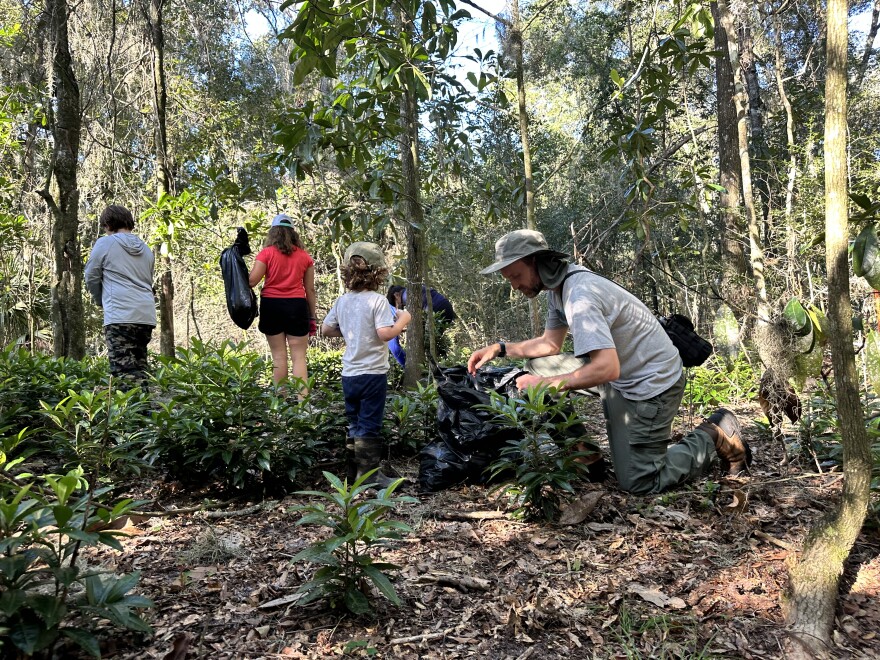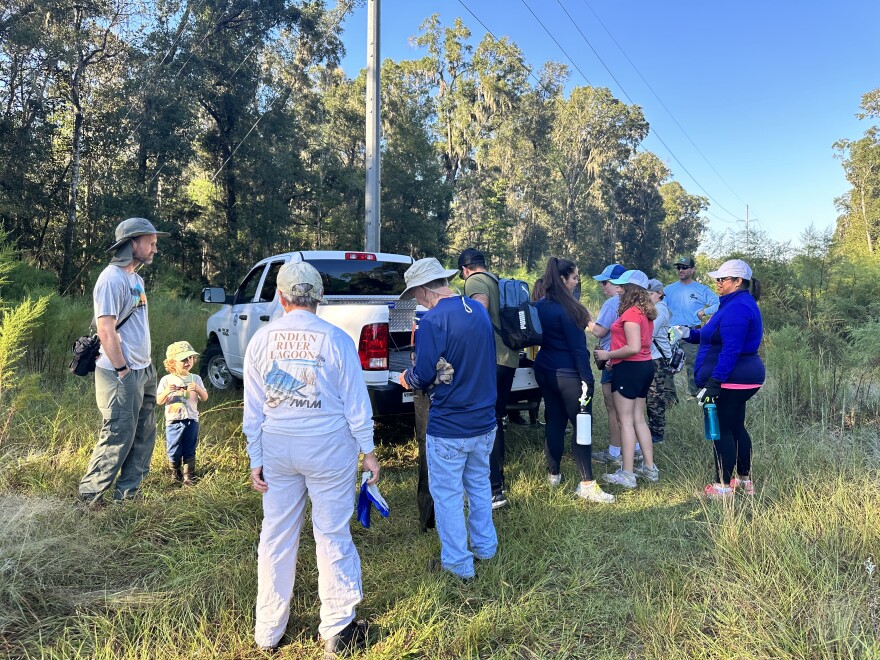For the first time, the 30th National Public Lands Day was open to volunteers from the public.
West of the Bass Pro Shop in Celebration Pointe, 13 volunteers participated at Lake Kanapaha Park by pulling invasive coral ardisia, a non-native plant that displaces native trees and shrubs in the forest. Volunteers sprayed themselves with bug spray, put on their gloves and sat down in the dirt to do their part to protect the land from the invasive species.
“I think we’re helping make the world a better place,” Girl Scout Arianna Briggs, 13, said.
Ariana, along with a dozen others, pulled invasive coral ardisia from the flagged area of approximately 30 feet. The area was marked by orange tape that read “invasive species.” Invasive species are non-native plants that spread rapidly and harm native plants and the surrounding ecosystem. Flags blocked off the surrounding area that spans from private property to natural wetlands. By the end of the day, participants collected eight gallon-sized trash bags full of removed coral ardisia.
A Boy Scout, Rayce Walsh, participated with his mother, Catherine Walsh, and sister Carrington Walsh. Rayce came to the event for service hours to rank up to Scout Rank from Cadet.
“Since it’s invasive, it’s probably hurting the land somehow, so I think it’s going to] spread all over everybody’s yard and you’ll just have to keep putting it back,” Rayce, 11, said. “So, I’m hoping people doing this will put less work on other people.”
Girl Scout Carrington Walsh, 13, agreed with her brother when asked how invasive species hurt the environment. “So it doesn’t suffocate the other plants,” Carrington said.

The invasive bushes covered the ground and took effort to pull out of the dirt. Alone, the process would be almost impossible. In groups of two or three, volunteers on Saturday hand pulled the smaller coral ardisia. Contractors will take out the bigger bushes with herbicide in a few months.
“If I was out here by myself, I wouldn’t be hand pulling, I’d be out here with a backpack and herbicide, spraying it all,” Environmental Specialist of the Alachua County Environmental Protection Department Jesse Natwick said. “For one person, it’s a lot more effective to [use] herbicide. But if we have an opportunity with a bunch of people, it just reduces the amount of herbicide in the ground.”
The selective herbicide Natwick uses targets specific plants like the invasive coral ardisia, but he said there will be some off-target damage to the surrounding plants. Volunteers that hand pull the invasive species reduce the risk of off-target damage.
“I think it’s important to be involved in our community because it helps, well first, it helps make the world a better place and it’s good for people who aren’t Girl Scouts,” Arianna said. “To know that there are people taking action and helping the environment.”
The Girl and Boy Scout volunteers spent their Saturday morning weeding to gain volunteer hours to rank up and earn their Outdoor Journey for the Take Action Project.
“It’s to improve the quality of the community,” Carrington said.
But Rayce learned a lesson about community rather than just getting volunteer hours.
“I think it’s important to be out here to help the environment and to see all the other people that are willing to use their time to come out here to help the environment and help other people,” Rayce said. “‘Cause it could have just been that guy (Natwick) alone coming out here, which would have taken much many more hours without us.”
Volunteers learned about the community and serving not only the land but the people too. Service was a common theme for these Girls and Boys Scouts who came to volunteer their time outdoors.
“I think service is a pretty decent answer,” Carrington said in an interview about the importance of the volunteer event.
Natwick thinks there is still more work to do.
“The picture that I get for people who volunteer is to give people a sense of ownership for the public lands,” Natwick said. “We could put a sign out here and say ‘protect it’ and then come out here once in a while and just check the plant life and survey, but it’s the general public that also helps protect the lands.”
The community plays a part in protecting public lands so the public can enjoy them, Natwick said. More than just invasive species, the development of houses and private property near the conservation land threatens the land and its natural resources.
“It’s just giving people an opportunity to see it and help preserve this land from development as well,” he said.
Natwick hopes that people will feel ownership of lands and protect them beyond the volunteer event.
“Once you put your hands in the ground and see what’s really out here, you have a better sense of what we’re protecting and not just hearing it,” Natwick said.
He hopes the community will take action once they see and make a connection to the public lands.
Natwick said people can help watch out for those who try to do something they shouldn’t be doing on public lands.
“I would hope that people that are coming out to volunteer or learning about the area want to stop these people or they’re calling us or someone who’s managing it,” he said.
Natwick said he hopes people will try to protect the land past just volunteer events.
“I think that getting people to realize what coral ardisia is and once you start hand pulling it and seeing it,” Natwick said. “And you know it’s a bad plant, hopefully, those people will either pull the plants up or tell your neighbors that’s not a good plant to have.”
Carrington thinks the efforts on Saturday can spread further than just a volunteer group on National Public Lands Day.
“It only takes one to set off a chain reaction,” she said.





